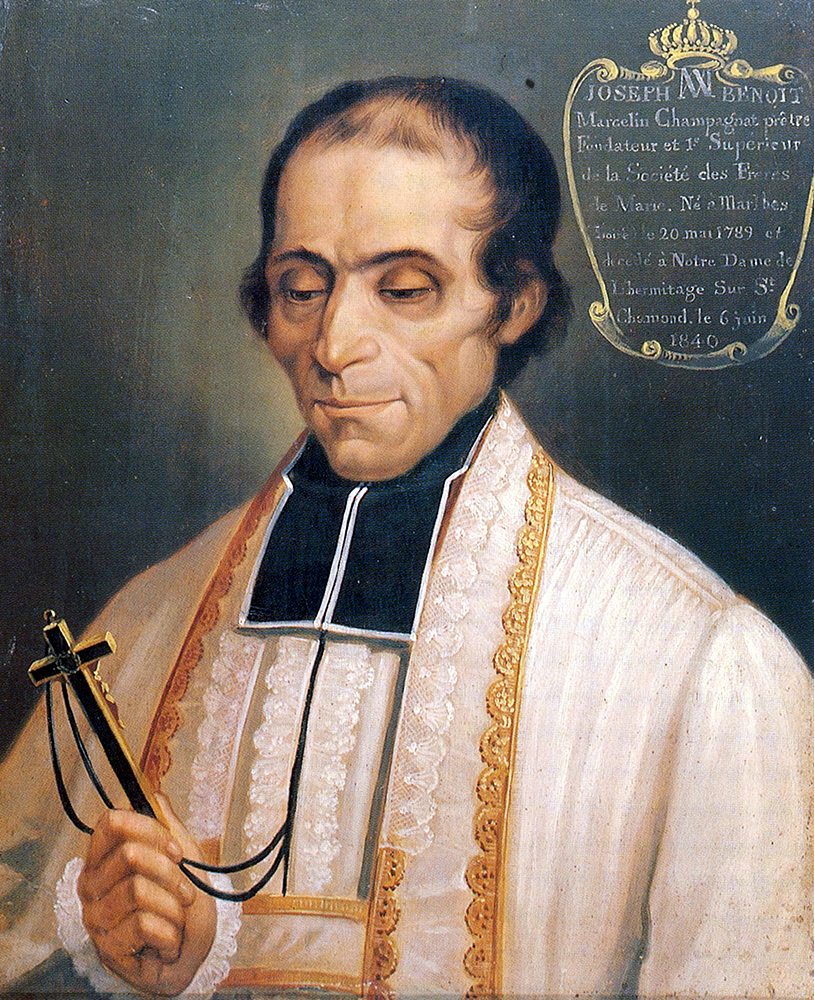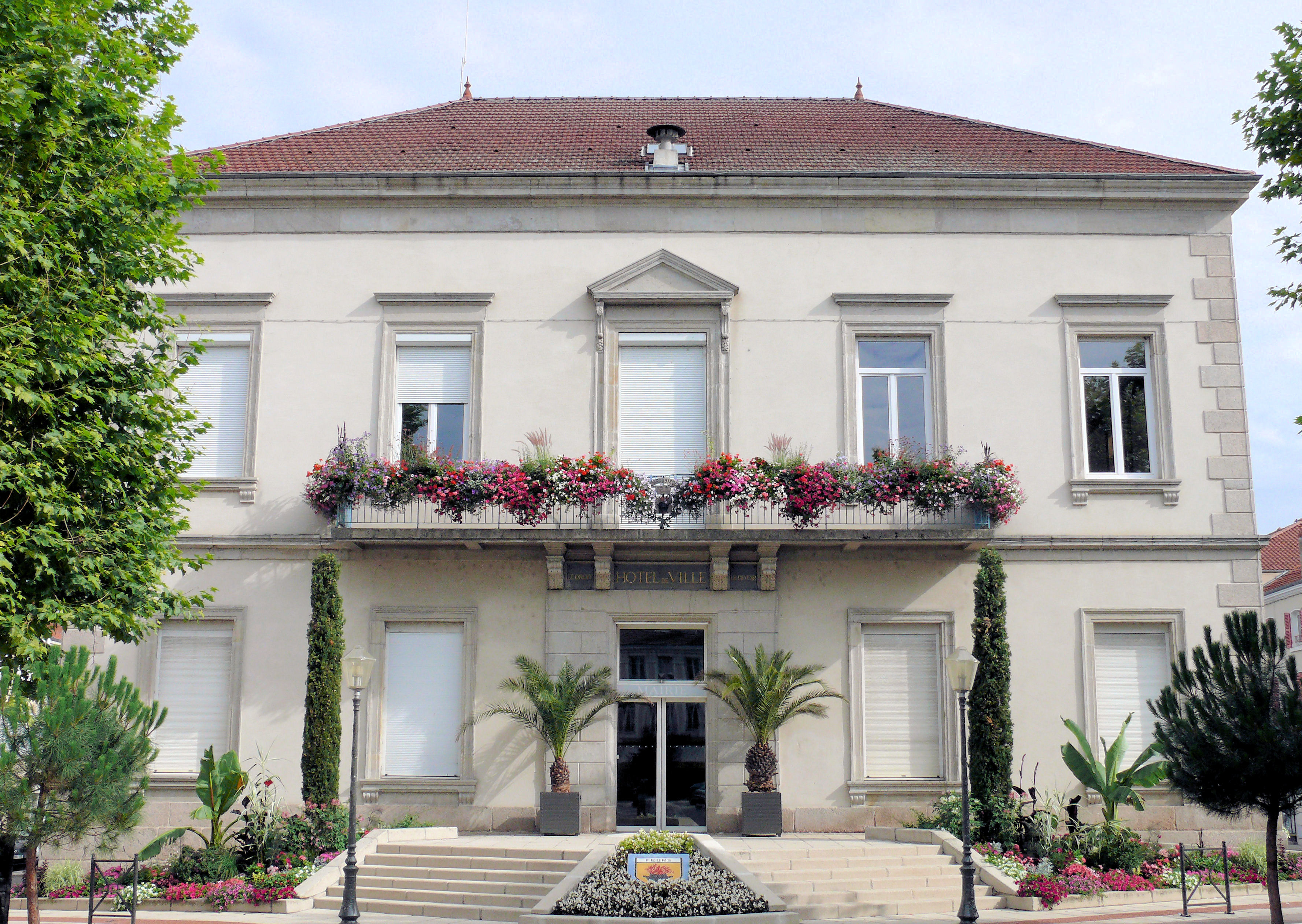|
Jean-Claude Courveille
Jean-Claude Courveille (15 May 1787 – 15 September 1866) was a Catholic priest who took the initiative of establishing the Marists, or Society of Mary, of which he was the first superior general. Following a scandal, he retired to Cistercian abbey of Notre-Dame of Aiguebelle, then Saint-Antoine-l'Abbaye and finally to the Benedictine Solesmes Abbey, where he died. Early years Jean-Claude Courveille was the son of Marguerite Beynieux and Claude Courveille, a merchant of Usson-en-Forez. He was born in this town on 15 May 1787. During the French Revolution his parents, devout Catholics, hid in their house a statue of the Virgin that was venerated in the village as "Our Lady of Chambriac" and was said to have miraculous powers. The boy suffered from smallpox in 1797, and injury to his cornea made him half-blind. He lost his father in 1805. The statue of Our Lady of Le Puy-en-Velay in Le Puy Cathedral was burned during the revolution on 8 June 1794 by Louis Guyardin, who had been ... [...More Info...] [...Related Items...] OR: [Wikipedia] [Google] [Baidu] |
Usson-en-Forez
Usson-en-Forez (, literally ''Usson in Forez'') is a commune in the Loire The Loire (, also ; ; oc, Léger, ; la, Liger) is the longest river in France and the 171st longest in the world. With a length of , it drains , more than a fifth of France's land, while its average discharge is only half that of the Rhône ... Departments of France, department in central France. Population Personalities *Congregation of the Mission, Lazarite priest Jean-Claude Faveyrial (1813–1893), author of the first book on the history of Albania. See also *Communes of the Loire department References Communes of Loire (department) {{Loire-geo-stub ... [...More Info...] [...Related Items...] OR: [Wikipedia] [Google] [Baidu] |
Basilica Of Notre-Dame De Fourvière
The Basilica of Notre-Dame de Fourvière (french: Basilique Notre-Dame de Fourvière) is a minor basilica in Lyon, France. It was built with private funds between 1872 and 1896 in a dominant position overlooking the city. The site it occupies was once the Roman forum of Trajan, the ''forum vetus'' (old forum), thus its name (as an inverted corruption of the French ''Vieux-Forum''). Role in the history and life of the city Fourvière is dedicated to the Virgin Mary, to whom is attributed the salvation of the city of Lyon from the bubonic plague that swept Europe in 1643. Each year in early December (December 8, day of the Immaculate Conception), Lyon thanks the Virgin for saving the city by lighting candles throughout the city, in what is called the Fête des Lumières or the Festival of Lights. The Virgin is also credited with saving the city a number of other times, such as from a Cholera epidemic in 1832, and from Prussian invasion in 1870. During the Franco-Prussian War (1870 ... [...More Info...] [...Related Items...] OR: [Wikipedia] [Google] [Baidu] |
Saint-Clair-du-Rhône
Saint-Clair-du-Rhône (, literally ''Saint-Clair of the Rhône'') is a commune in the Isère department in southeastern France. Population Twin towns Saint-Clair-du-Rhône is twinned with: * Mammola, Italy, since 2010 See also *Communes of the Isère department The following is a list of the 512 Communes of France, communes in the French Departments of France, department of Isère. The communes cooperate in the following Communes of France#Intercommunality, intercommunalities (as of 2020): References Communes of Isère Isère communes articles needing translation from French Wikipedia {{Isère-geo-stub ...[...More Info...] [...Related Items...] OR: [Wikipedia] [Google] [Baidu] |
Trappists
The Trappists, officially known as the Order of Cistercians of the Strict Observance ( la, Ordo Cisterciensis Strictioris Observantiae, abbreviated as OCSO) and originally named the Order of Reformed Cistercians of Our Lady of La Trappe, are a Catholic religious order of cloistered monastics that branched off from the Cistercians. They follow the Rule of Saint Benedict and have communities of both monks and nuns that are known as Trappists and Trappistines, respectively. They are named after La Trappe Abbey, the monastery from which the movement and religious order originated. The movement first began with the reforms that Abbot Armand Jean le Bouthillier de Rancé introduced in 1664, later leading to the creation of Trappist congregations, and eventually the formal constitution as a separate religious order in 1892. History The order takes its name from La Trappe Abbey or ''La Grande Trappe'', located in the French province of Normandy, where the reform movement began. Ar ... [...More Info...] [...Related Items...] OR: [Wikipedia] [Google] [Baidu] |
Aiguebelle Abbey
Aiguebelle Abbey (french: Abbaye Notre-Dame d'Aiguebelle) is a Trappist monastery situated in the communes of Montjoyer and Réauville in the ''département'' of Drôme, on the borders of the Dauphiné and of Provence, France. History Benedictines The first monastery here was Benedictine, founded in 1045 by Hugues Adhemar, baron of Grignan, and visited by Pope Paschal II in 1107, but shortly afterwards it fell into disuse. Cistercians The abbey was re-founded as a Cistercian monastery by Gontard Loup, lord of Rochefort-en-Valdaine, in 1137, and settled from Morimond Abbey, of which it was a daughter house. The founder endowed it with land nearby, and through the 12th and 13th centuries other benefactors added to its lands, thus ensuring its prosperity. Already by 1167 it was sufficiently established to found a daughter house of its own, Fénier Abbey, closely followed by Le Bouchet Abbey in 1169. By the end of the 13th century the abbey was extremely well established and infl ... [...More Info...] [...Related Items...] OR: [Wikipedia] [Google] [Baidu] |
Jean Claude Colin
Jean may refer to: People * Jean (female given name) * Jean (male given name) * Jean (surname) Fictional characters * Jean Grey, a Marvel Comics character * Jean Valjean, fictional character in novel ''Les Misérables'' and its adaptations * Jean Pierre Polnareff, a fictional character from ''JoJo's Bizarre Adventure'' Places * Jean, Nevada, USA; a town * Jean, Oregon, USA Entertainment * Jean (dog), a female collie in silent films * "Jean" (song) (1969), by Rod McKuen, also recorded by Oliver * ''Jean Seberg'' (musical), a 1983 musical by Marvin Hamlisch Other uses * JEAN (programming language) * USS ''Jean'' (ID-1308), American cargo ship c. 1918 * Sternwheeler Jean, a 1938 paddleboat of the Willamette River See also *Jehan * * Gene (other) * Jeanne (other) * Jehanne (other) * Jeans (other) * John (other) John is a common English name and surname: * John (given name) * John (surname) John may also refer to: New Te ... [...More Info...] [...Related Items...] OR: [Wikipedia] [Google] [Baidu] |
Saint-Chamond, Loire
Saint-Chamond () is a commune in the Loire department in the Auvergne-Rhône-Alpes region in central France. Situated 13 km northeast of the city of Saint-Étienne and 50 km southwest of Lyon, the town dates back to the Roman period. It lies in an iron and coal region, which were the basis of industrial growth during the 19th and 20th centuries. As many of the mines and factories closed in the late 20th century due to restructuring, there was a loss of jobs and population. The present city of Saint-Chamond is the result of the merger in 1964 of the communes of Saint-Martin-en-Coailleux, Saint-Julien-en-Jarez, Izieux and Saint-Chamond. The new town is the third-largest town in the department. Location Saint-Chamond is located in the Gier valley between the Monts du Lyonnais to the north and Mont Pilat to the south. The peak of Perdrix, at is the highest in the Pilat massif. The "Saut du Gier" waterfall is in the Pilat Regional Natural Park. The peak of Œillon pro ... [...More Info...] [...Related Items...] OR: [Wikipedia] [Google] [Baidu] |
Joseph Fesch
Joseph Fesch, Prince of France (3 January 1763 – 13 May 1839) was a French priest and diplomat, who was the maternal half-uncle of Napoleon Bonaparte (half-brother of Napoleon's mother Laetitia). In the wake of his nephew, he became Archbishop of Lyon and Cardinal. He was also one of the most famous art collectors of his period, remembered for having established the Musée Fesch in Ajaccio, which remains one of the most important Napoleonic collections of art. Born in Corsica, he was the son of Swiss-born Franz Faesch and Angela Maria Pietrasanta, and belonged on his father's side to the Faesch family, one of the most prominent patrician families of Basel. He rose to great prominence in France following Napoleon's coup d'état of 1799. Fesch became Archbishop of Lyon in 1802, a Cardinal in 1803, Ambassador to the Holy See in 1804, a French senator and count in 1805, Grand Almoner of France in 1805, a sovereign prince in 1806, Prince of France in 1807 (a dignity he shared only ... [...More Info...] [...Related Items...] OR: [Wikipedia] [Google] [Baidu] |
Charlieu
Charlieu (; frp, Charluè) is a Communes of France, commune in the Loire (department), Loire Departments of France, department at the northern end of the Auvergne-Rhône-Alpes region of France. It is home to Charlieu Abbey. Population Twin towns It is twinned with the town of Calne in Wiltshire, UK. See also *Communes of the Loire department References External links Town website Communes of Loire (department) Lyonnais {{Loire-geo-stub ... [...More Info...] [...Related Items...] OR: [Wikipedia] [Google] [Baidu] |
Feurs
Feurs (; frp, Fuèrs) is a commune in the department of Loire, Auvergne-Rhône-Alpes, France. History Antiquity The city was founded by the Romans. The name Feurs is a contraction of ''Segusiavorum Forum''. With a forum the Gallo-Roman era, city was the capital of Ségusiaves as is indicated by Ptolemy and appears on the Tabula Peutingeriana. By extension, the city gave its name to Forez. Vestiges of the ancient Roman city are located by the current post office. Archaeologists have unearthed a theater, sewers, milestones, inscriptions, statuettes and pottery that reflect the importance, at that time, of the Roman the town, located near important Roman roads. Middle Ages A church dedicated to St. Baudile is reported in 960. A second dedicated to the Virgin Mary appears in the texts in 1001. A Castle in Feurs is reported in 1246. In the Middle Ages, the city had no bridge over the Loire but there was a harbor(953) and another close to Randans (1060). File:Vestiges de la cur ... [...More Info...] [...Related Items...] OR: [Wikipedia] [Google] [Baidu] |
La Valla-en-Gier
La Valla-en-Gier () is a commune in the Loire department in central France. Population See also *Communes of the Loire department The following is a list of the 323 communes of the Loire department of France. The communes cooperate in the following intercommunalities (as of 2020):Communes of Loire (department) {{Loire-geo-stub ... [...More Info...] [...Related Items...] OR: [Wikipedia] [Google] [Baidu] |



%2C_château_des_seigneurs_de_et_église_collégiale%2C_sur_la_colline_Saint-Ennemond%2C_gravure_1644.jpg)

